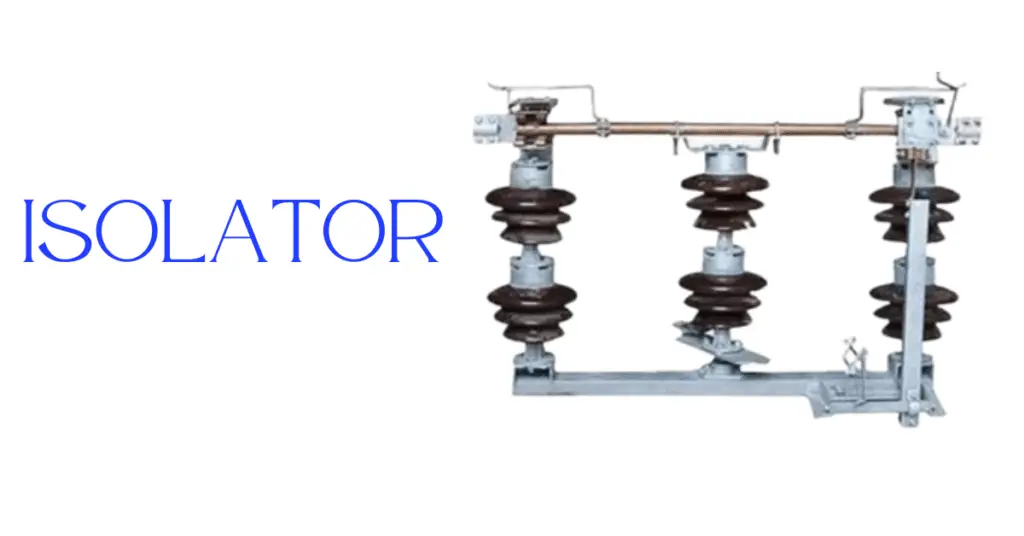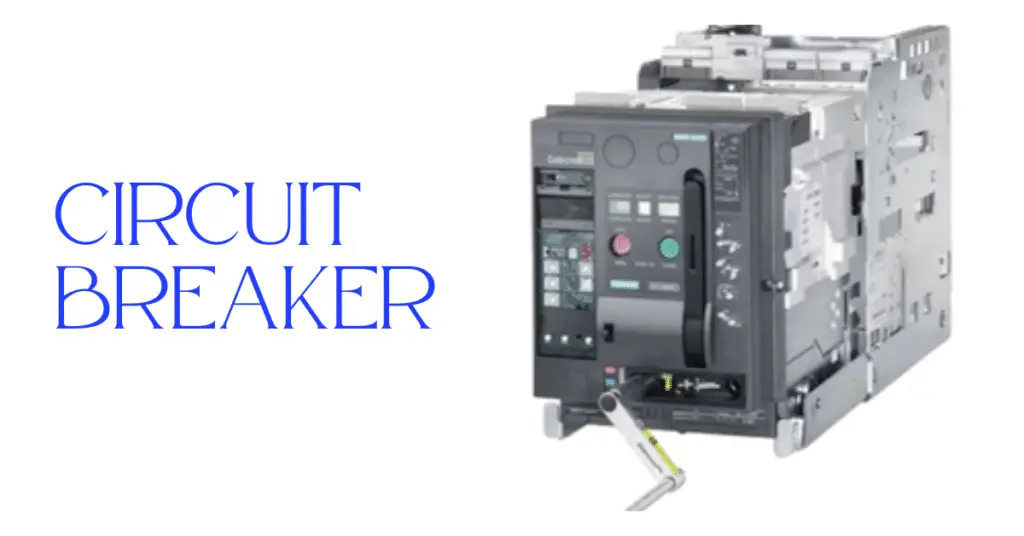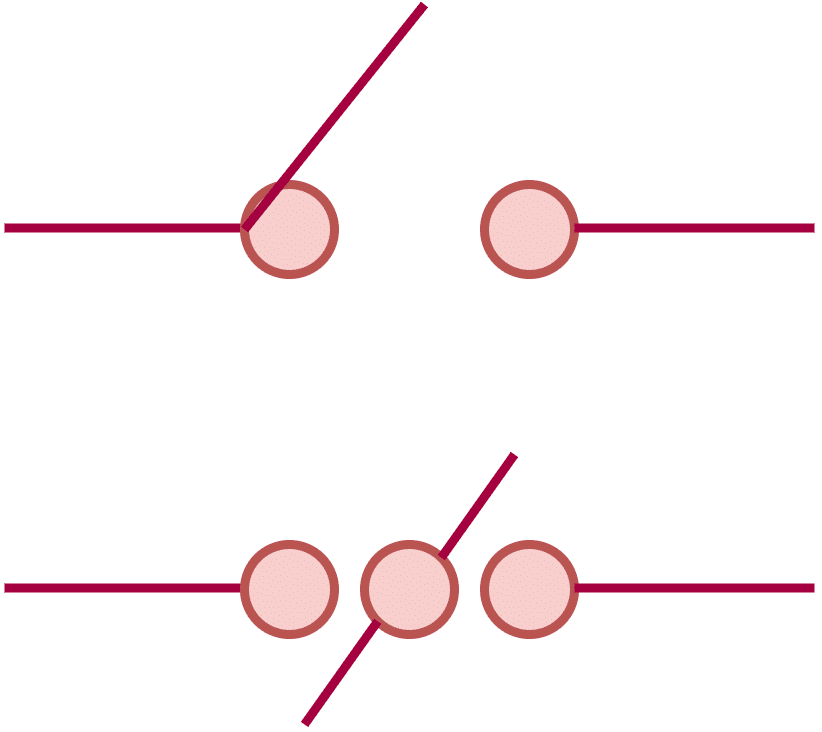The main difference between an isolator and a circuit breaker is that an isolator is an off-load on/off device, while a circuit breaker is an on-load protective device.
Switching devices play a vital role in safeguarding numerous electrical machines and appliances. The two most prominent and widely used switching gears are – circuit breakers and isolators. Both circuit breakers and isolators function by tripping the circuit when excess current flow is detected.
In this article, we will discuss the key differences between circuit breakers and isolators. But before going into the differences, let’s first understand how a circuit breaker and isolator operate.
What is an Isolator?
An isolator is an electrical switching device that is used to detach or disconnect certain components of the circuit or the entire electrical circuit when the electrical load is zero. Another name for an isolator is a disconnector. Isolator functions by tripping the switch when there is no current flow in the circuit. Additionally, an isolator is designed as a distinct circuit element for ensuring the safety of the electronic components or machines connected to the circuit.

The main area of application of a switch isolator is to isolate the electrical circuit when any sort of maintenance activities are to be carried out on electrical equipment. The isolator safeguards the lives of electricians and other workers when they work on a faulty transmission line for repairing/ troubleshooting. One thing to be kept in mind is that while working on a faulty line, the corresponding line isolator must be in the off position in order to ensure the safety of the worker’s life.
An isolator is a disconnecting switch unit that operates under off-load conditions and isolates the faulty part of the electrical circuit from the main supply.
Isolators are installed before the circuit breaker. The on-load circuit is first switched off by the circuit breaker and then the isolator is switched off. Again, for energization of the electrical supply, the isolator is first made on and then the circuit breaker is switched on. The isolator must be switched on or off when the circuit current is zero.
Never switch off the isolator when the current is flowing through it. It is a off load switching device. First, make the circuit current zero by switching off the circuit by a downstream circuit breaker.
Switch on the isolator when there is no current in the circuit. For this, we need to isolate the circuit by ensuring off condition of a downstream circuit breaker.
What is a Circuit Breaker?
A Circuit Breaker is a protective device that safeguards the electrical circuit and apparatus from damage due to major faults in the circuitry. A circuit breaker is an electrical switch that trips the circuit on receiving the trip command from the protection relay.

Circuit breakers are either manually operated or automated. The main reason that makes a circuit breaker preferable as compared to a fuse is that it need not be replaced, but it can be reset and can be used in the circuit again. The main functional operation of a circuit breaker is to protect the electrical network during the occurrence of faults, short circuits, and overloading of the circuitry.
A circuit breaker makes use of a relay for detecting the circuit faults, and it prohibits the flow of electric current through the network components in order to prevent any kind of damage to the electrical and electronic equipment connected to the circuit.
A circuit breaker can open and close the electrical circuit at the normal and fault current. It disconnects the faulty section when an overload current or short circuit current flows through it.
Circuit breakers are used for heavy mechanical loads that draw a high current. Besides the protection of the electric circuit from overcurrent, the circuit breakers also shield the circuit from other electronic problems such as high voltage, circuit overloading, short-circuiting, etc.
Additionally, circuit breakers find their applications as switches in an electronic circuit besides circuit safety. Moreover circuit breakers have the ability to function under active load conditions with the help of an extinguishing system that is built inside the circuit breaker.
Difference between Isolator and Circuit Breaker
The following table lists the most prominent differences existing between an isolator and a circuit breaker as follows.
| Parameter | Isolator | Circuit Breaker |
| Definition | An isolator is an electric switchgear used to trip the circuit from the main power grid on detecting any circuit faults. | A circuit breaker is also a protective device that shields the electric circuit from damage due to faults, short circuits, high voltages, etc. |
| Principle of operation | An isolator works by detaching the faulty component of the circuit so that it can be repaired safely by the electrician. | A circuit breaker function is based on the concept of internal switching. It trips and disconnects the circuit when a fault, current, or voltage overflow and overloading is detected in the electric circuit. |
| Construction | An isolator is constructed as a basic mechanical switch. | A circuit breaker is comprised of an electromechanical switching part along with an integrated relay system. |
| Mode of operation | An isolator can function only in a manual fashion. However, nowadays motorized isolators are also available. | A circuit breaker can function in a both manual and automated manner. |
| Device types | An isolator is a device that cannot be operated under active load conditions. It can be operated when there is no current flow in the circuit. Therefore, it is a off-load device. | A circuit breaker is a device that can be operated under active load conditions. The breaker can be switched on or off during the flow of electric current in the circuit. It can interrupt the nominal current and fault current. Therefore, it is an on-load device. |
| Functionality | An isolator is used for positive isolation of the supply system to repair and maintain the faulty section. Thus, it ensures the safety of the person working on the electrical system for maintenance/repair/troubleshooting. | A circuit breaker only performs the function of interrupting the electric current flowing in the circuit. When the breaker receives a trip command from the relay under fault, it isolates the unhealthy system from a healthy system. |
| ON-Load Operation | Not suitable for on-load operation | Suitable for on-load operation |
| Types | Double Break, Center Break, Pantograph, Knee, Double Break, Center Break, | MCB (Miniature), ACB (Air circuit Breaker) AB(Air Blast Breaker), OCB (Oil), MOCB(Minimum oil circuit breaker)SF6, VCB(Vacuum Circuit breaker), etc. |
| Symbol |  | |
| Withholding capability | An isolator has a low capability to withhold current flow. It can not interrupt the nominal current and fault current. For isolation, first, the current through it is made zero. | A circuit breaker has a higher capability to withhold current flow. It has the capacity to break the nominal and fault current. thus, it has a higher breaking capacity. |
| Thermal Capability | Low | High |
| Insulation | An isolator is used for the isolation of the circuit when the current is zero. Therefore, air acts as an insulation medium between the live and separating parts. Therefore, its insulation level is low in comparison to the circuit breakers. | Circuit breakers are used to interrupt the nominal current as well as the fault current. Therefore, high insulation like oil, vacuum, and SF6 is used for arc quenching. |
| Power disruption | Isolator disrupts the flow of power only at the time of repair and maintenance. | Circuit breaker disrupts the current flow even during normal conditions or in the case of overloading or short circuit. |
| Voltage surges | An isolator is an off-load device therefore no overvoltage induce at the time of opening and closing of the isolator. | The circuit breaker interrupts the circuit on load, therefore there are chances of voltage surges during switching depending on the type of electrical load. |
| Contacts | It has main contacts and moving arm with blade contacts. | The circuit breaker has fixed and moving contacts. The air circuit breaker has arcing contacts in addition to fixed and moving contacts. |
| Relay usage | Isolator does not require a relay circuitry for its functioning. | Circuit breaker involves the use of relay circuitry to detect the faults in the system. |
| Earth switch | It has an earth switch arrangement. After disconnecting the faulty section, one end of the isolator is earthed to avoid any leakage current in the circuit taken for repair/maintenance purposes. | It does not have an earth switch. |
| Breakdown capability | An isolator has lower breakdown capability due to its inability to break down faults in loads. | A circuit breaker has higher breakdown capability due to its ability to break down faults in loads. |
| Expense | An isolator is comparatively less expensive. | A circuit breaker is comparatively costlier. |
| Applications | An isolator finds its applications in electrical power systems in commercial areas only to detach the faulty circuit element from the rest of the circuitry. | A circuit breaker safeguards heavy machinery having extensive current requirements. |
Conclusion
In conclusion, this article provided detailed information on isolators and circuit breakers in an electric circuit and how each operates to protect the circuit components from getting damaged. Although both the isolator and circuit breaker are safety devices, they have some notable differences between them as highlighted in this article.
The major difference that exists between these two components is that an isolator functions when we disconnect it from the supply system for maintenance and repair purposes, while, a circuit breaker opens and close the circuit under normal condition, and trips the circuit under fault condition.